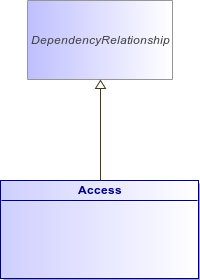
ArchiMate Metamodel
The access relationship indicates that a process, function, interaction, service, or event "does something" with a passive structure element; e.g., create a new object, read data from the object, write or modify the object data, or delete the object. The relationship can also be used to indicate that the object is just associated with the behavior; e.g., it models the information that comes with an event, or the information that is made available as part of a service.
The arrow head, if present, indicates the direction of the flow of information. (The access relationship should not be confused with the UML dependency relationship, which uses a similar notation.)
Note that, at the metamodel level, the direction of the relationship is always :
- from an active structure element or a behavior element
- to a passive structure element,
although the notation may point in the other direction to denote 'read' access, and in both directions to denote read-write access.
Care must be taken when using access with derived relationships because the arrow on the relationship has no bearing to its directionality. Directionality on an access relationship is always from a behavior element to a passive element.
Alternatively, an access relationship can be expressed by nesting the passive structure element inside the behavior or active structure element that accesses it; for example, nesting a data object inside an application component.
The usual interpretation of an access relationship is that the whole of the source element is accessed by the target element. This means that if, for example, the same internal behavior element accesses two passive structure elements, both of these passive structure elements are needed. If two passive structure elements are, for example, alternative information sources and only one of them is needed by the internal behavior element, an or junction can be used.

Attribute | Description |
|---|---|
AccessMode mode [1..1] |